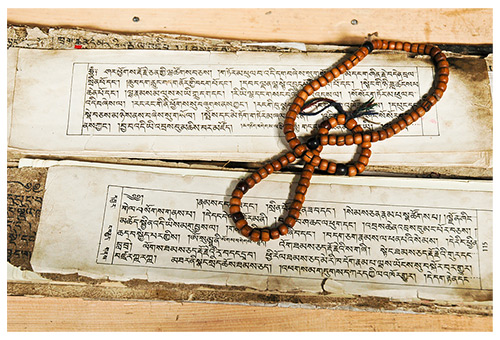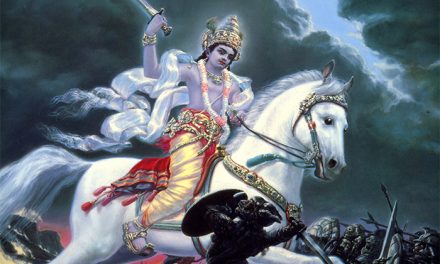[ From the IndiaDivine email discussion group. ]
Since the topic has come up, I would like to write a little bit on the topic of religion and conversion as taught within our Vedic texts.
The word “dharma” does not refer to a particular sectarian faith, but to the very function of the soul. The shastras teach us that it is the inherent nature of everyone to render service. When that service is directed ultimately towards ourselves, in a selfish manner, it becomes the source of our own bondage in the material world. When that same service propensity is directed to the absolute truth, it becomes the key to our liberation from bondage. That selfless service, when directed towards the absolute is “sanatana-dharma”, or the eternal function of the living entity.
As is implied by the word “sanatana” (eternal) there is no question of changing or stopping this inherent nature of service. We may misdirect our service in a selfish manner, but we can never cease engaging in service. Thus dharma, or sanatana-dharma is not merely a matter of faith or belief, but it is the reality of the self. It is the quality of the soul.
The quality of an object does not change based on a belief or faith. Water does not become wet due to our belief that it is wet. It’s factual nature is that it is wet, regardless of faith or belief. The dharma of the soul is to engage in service; whether we believe or do not believe, whether we have faith or do not have faith, is irrelevant. We will factually engage in service, as it is our very quality. If we are selfless, our service will be directed towards the absolute; if we are selfish, our service will be directed towards our own senses, either directly or indirectly.
Religion, on the other hand, is a belief or faith held within the mind. One may today be a Christian, and tomorrow change one’s mind (or faith) to become a Muslim. Does this mental belief have any factual bearing on the eternal spirit soul? The answer is no. One should not give in to the waverings of the mind. The Gita teaches us to rise beyond the body, beyond the mind, beyond the intelligence, and to come to the point of understanding the eternal self, the soul or atma. Those who become attached to false mental conceptions of the self (material designations) remain in the shackles of avidya (ignorance) despite their external rituals of religion.
Material designations are nothing but the temptations of maya (illusion) for the mind. The body is tempted by external sense enjoyment, whereas the mind is tempted by false conceptions of the self. These material designations may be focused on religion, nation, family, caste, creed, or belief. All of them are blocks on the path of self-realization.
The great saint Sri Chaitanya Mahaprabhu has taught us that we are not the external material body or its temporary designations, but are factually an eternal servant of the absolute. To convert from one aspect of ignorance to another is meaningless. It simply satisfies an uncontrolled mind, which finds peace in constant change. Like the flickering of a candle flame, the mind pushes us to waver between various mental conceptions of identity (religion, nationality, race, etc.). These shallow changes of belief have no factual effect on the soul. They only increase our bondage by creating a false conception of accomplishment.
Sri A.C. Bhaktivedanta Swami Prabhupada, our divine master and guide, has stated in his introduction to Bhagavad Gita the following, which clearly explains the distinction between religion and sanatana-dharma (the eternal function of the soul):
‘Sanatana-dharma does not refer to any sectarian process of religion. It is the eternal function of the eternal living entities in relationship with the eternal Supreme Lord. Sanatana-dharma refers, as stated previously, to the eternal occupation of the living entity. Ramanujacarya has explained the word sanatana as “that which has neither beginning nor end,” so when we speak of sanatana-dharma, we must take it for granted on the authority of Sri Ramanujacarya that it has neither beginning nor end.’
‘The English world “religion” is a little different from sanatana-dharma. Religion conveys the idea of faith, and faith may change. One may have faith in a particular process, and he may change this faith and adopt another, but sanatana-dharma refers to that activity which cannot be changed. For instance, liquidity cannot be taken from water, nor can heat be taken from fire. Similarly, the eternal function of the eternal living entity cannot be taken from the living entity. Sanatana-dharma is eternally integral with the living entity. When we speak of sanatana-dharma, therefore, we must take it for granted on the authority of Sri Ramanujacarya that it has neither beginning nor end. That which has neither end nor beginning must not be sectarian, for it cannot be limited by any boundaries. Yet those belonging to some sectarian faith will wrongly consider that sanatana-dharma is also sectarian, but if we go deeply into the matter and consider it in the light of modern science, it is possible for us to see that sanatana-dharma is the business of all the people of the world–nay, of all the living entities of the universe.’
‘Non-sanatana religious faith may have some beginning in the annals of human history, but there is no beginning to the history of sanatana-dharma because it remains eternally with the living entities. Insofar as the living entities are concerned, the authoritative sastras state that the living entity has neither birth nor death. In the Gita it is stated that the living entity is never born, and he never dies. He is eternal and indestructible, and he continues to live after the destruction of his temporary material body. In reference to the concept of sanatana-dharma, we must try to understand the concept of religion from the Sanskrit root meaning of the word. Dharma refers to that which is constantly existing with a particular object. We conclude that there is heat and light along with the fire; without heat and light, there is no meaning to the word fire. Similarly, we must discover the essential part of the living being, that part which is his constant companion. That constant companion is his eternal quality, and that eternal quality is his eternal religion.’ – From “Introduction to Bhagavad Gita” by Sri Bhaktivedanta Swami Prabhupada.












